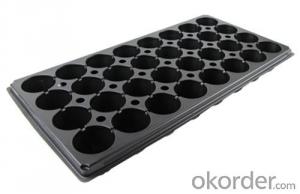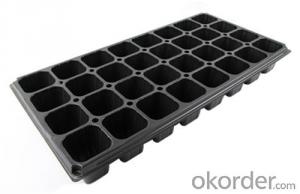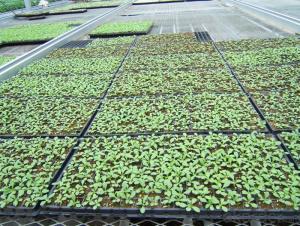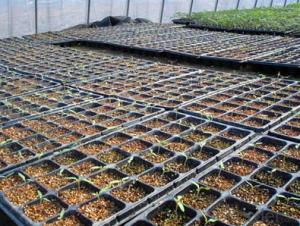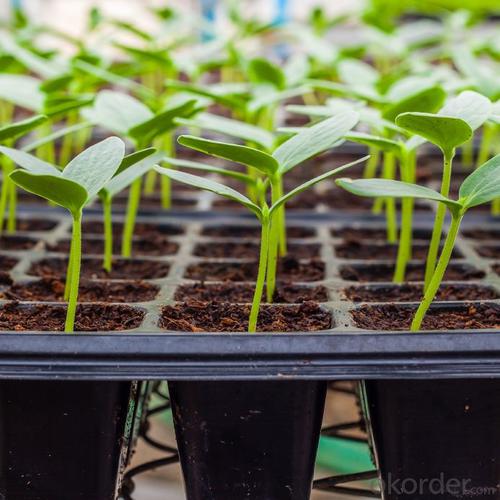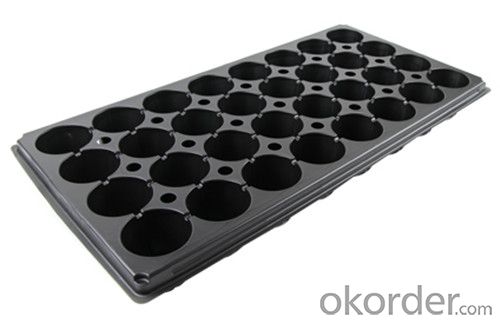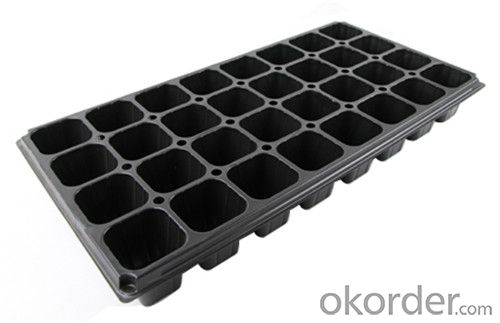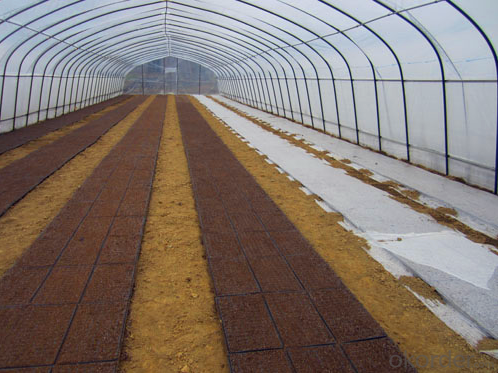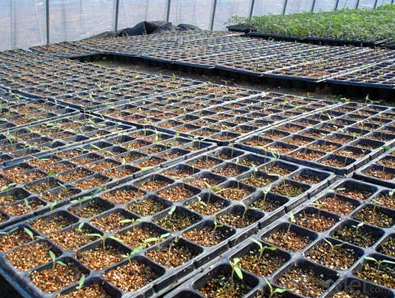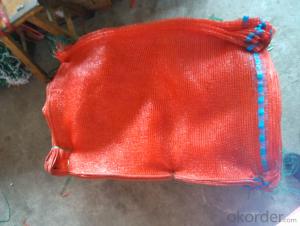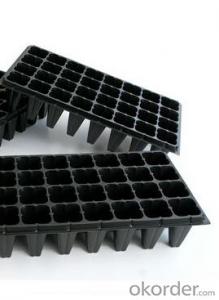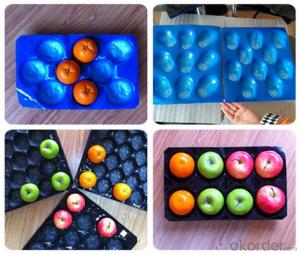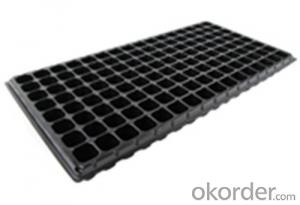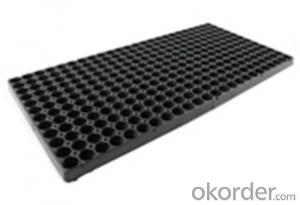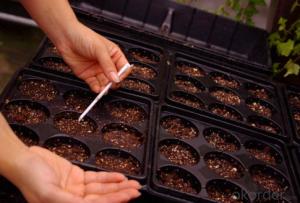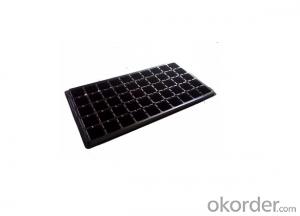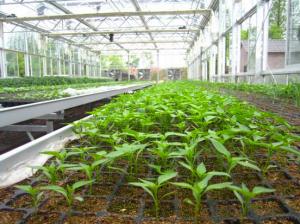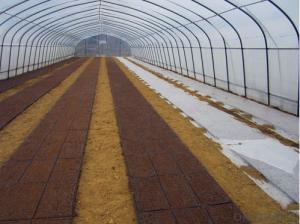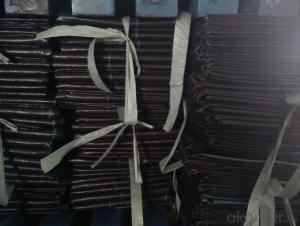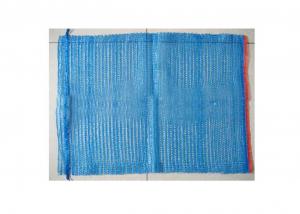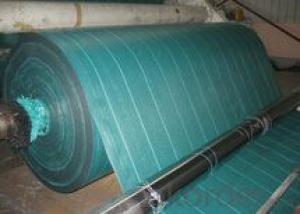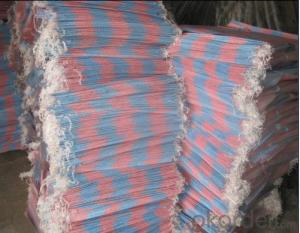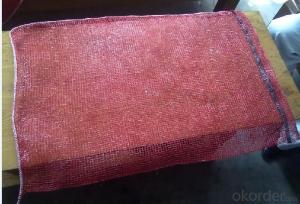Nursery Tray Seed Tray,Nursery Tray,Planter Tray
- Loading Port:
- China main port
- Payment Terms:
- TT OR LC
- Min Order Qty:
- 2000 pc
- Supply Capability:
- 10000000 pc/month
OKorder Service Pledge
OKorder Financial Service
You Might Also Like
Structure of the seed tray:
· Top quality and competitive price.
· Variety design and good appearance.
· Easy to use, and remove.
· Durable and reusable.
· Eco-Friendly.
Description Main Features of the seed tray:
· Ideal for Starting seeds and Transplanting Seedling.
· Suitable for both manual and automatic planting.
· Suitable for Propagating Vegetables, Flowers and other plant from seed in green-house or indoors.
Thickness vs. Weight
· Thickness of trays are from 0.5mm to 1.0mm.
· 1.0mm: 155g±5g; 100pcs/ctn.
· 0.9mm: 140g±5g; 120pcs/ctn.
· 0.7mm: 110g±5g; 150pcs/ctn.
· 0.6mm: 95g±5g; 180pcs/ctn.
· 0.5mm: 80g±5g; 200pcs/ctn.
·
Using time:
· thickness of 0.5mm can be used 1 to 2 times.
· thickness of 0.6mm can be used 3 to 4 times.
· thickness of 0.7mm can be used 5 to 6 times.
· thickness of 0.8mm can be used 7 to 8 times.
· thickness of 0.9mm can be used 8 to 9 times.
· thickness of 1.0mm can be used 8 to 10 times.
Seed Tray Specification:
Material | ps/pvc |
Thickness | 0.5mm-1.5mm, standard:1mm |
Weight | 80g(±5)g-230g(±5)g, Standard weight:155g(±5)g |
Size | length:490mm-540mm, width:190mm-345mm,depth:25mm-150mm Standard:54mmX28mm |
Cell count | 18-512 |
Package | in carton |
Using time | 8-10 times |
FAQ:
Q:How Can I Get A Sample?
A:You can get samples by communicate with our export sales.
Q:How Long Is Delivery?
A:Delivery time will be 7-25 days according to order quantity.
Q:What Is The MOQ?
A:Our MOQ is 1*20FT container quantity, allow to mix several items.
Q:What Is Our Normal Payments Terms?
A:Our normal payment terms now is T/T, L/C or Western Union,Papal.
Q:How Do I Order Your Products?
A:You can check our website for any items you interest and you can also get communication with our export sales and order for it accordingly.
Q:What Kinds Of Material We Use In Our Product?
A:Our plastic flower pots use material such as PP polymer or PE polymer.
- Q: Can agricultural plastic products be used for fence posts?
- Yes, agricultural plastic products can be used for fence posts. Agricultural plastics, such as high-density polyethylene (HDPE) or recycled plastic materials, are known for their durability, resistance to decay, and low maintenance requirements. These qualities make them suitable for use as fence posts, providing a cost-effective and long-lasting alternative to traditional wooden or metal posts. Additionally, using agricultural plastic products for fence posts can contribute to environmental sustainability by promoting the reuse of plastic waste and reducing reliance on natural resources.
- Q: I want to get custom plastic parts molded. Where can I get it or how can I do it myself?
- Custom okorder /
- Q: How do you choose ground cover plants that complement your existing landscape?
- When choosing ground cover plants that complement your existing landscape, it is important to consider several factors. Firstly, assess the overall style and theme of your landscape. If you have a formal garden, opt for symmetrical and neatly trimmed ground cover plants such as creeping thyme or moss. For a more natural or wildflower-inspired landscape, consider native species like creeping phlox or violets. Additionally, take into account the color scheme of your existing plants and flowers. Choose ground cover plants that either harmonize or provide a contrasting pop of color. For example, if you have predominantly green foliage, adding ground covers with vibrant flowers like creeping sedum or creeping phlox can create a stunning visual impact. Moreover, consider the maintenance requirements and growing conditions of the ground cover plants. Ensure they are compatible with the amount of sunlight, soil type, and moisture levels in your landscape. Choosing plants that thrive in the same conditions as your existing plants will make maintenance and care easier. Lastly, think about the purpose of the ground cover plants. Are you looking to fill in gaps between larger plants, prevent erosion on slopes, or create a low-maintenance lawn alternative? Understanding the specific function you want the ground covers to serve will help guide your selection. By carefully considering the style, color scheme, maintenance needs, growing conditions, and purpose of the ground cover plants, you can choose varieties that beautifully complement your existing landscape.
- Q: i just got a plastic filling in my tooth to seal a lingual cavity. are plastic fillings still just as secure?
- It isn't really plastic..it is also known as a composite or resin filling. It is actually stronger because It bonds with the collagen in the tooth enamel. it isnt just shoved into a drilled hole like an amalgam filling it is bonded to the dentin or enamel. it will hold for much longer. also another plus is because it is not metal it will not conduct as much cold or heat, helps with sensitive teeth.
- Q: Can nursery trays be used for starting succulent leaf cuttings?
- Yes, nursery trays can be used for starting succulent leaf cuttings. Nursery trays provide a suitable environment for propagating succulent leaves, allowing for proper drainage and airflow. It is important to use well-draining soil and mist the cuttings occasionally to maintain moisture levels.
- Q: What's the approxamative melting point of the plastic of a pen tube. Celsius and Farenheit please.
- Plastics do not have a melting point. Plastics usually get softer as the temperature rises. Many different plastics are used for making pens. Different formulas have different material properties. I do not know but becoming completely liquid may not happen in an atmosphere containing oxygen before combustion occurs.
- Q: non microwaveable plastic bowls, heard someone say something jw
- Rumor: Anyone who’s heated something up in the microwave has probably wondered about possible health effects. One common email exploits this fear by quoting information allegedly contained in a newsletter from Johns Hopkins University, adding that the “information is being circulated at Walter Reed Army Medical Center.” Various versions of this email say a Dr. Fujimoto from Castle Hospital was on a TV program warning that heating plastic in the microwave or freezing water in plastic bottles releases toxins, like dioxin and DEHA. In August 2004, the email took on new life when the name of an American Cancer Society staffer at the bottom of the email seemed to give the story real credibility. Fact: This email has its roots in a January 2002 appearance on KHON-TV, Honolulu by a genuine person, Dr. Edward Fujimoto, who apparently made these claims. The US Food and Drug Administration (FDA) on its Web site does say substances used to make plastics can leach into foods. But the agency has found the levels expected to migrate into foods to be well within the margin of safety based on information available to the agency. As for dioxin, the FDA says it “has seen no evidence that plastic containers or films contain dioxins and knows of no reason why they would.”
- Q: Can ground cover plants be used to create a natural-looking border or edge?
- Yes, ground cover plants can be used to create a natural-looking border or edge. Ground cover plants are low-growing plants that spread and fill in empty spaces, providing a lush and dense carpet-like effect. Their ability to cover large areas and their adaptability make them ideal for creating borders or edges that blend seamlessly with the surrounding landscape. Additionally, ground cover plants offer various colors, textures, and foliage, allowing for customization and enhancing the overall aesthetics of the border or edge.
- Q: Can ground cover be used in between pavers or stepping stones?
- Yes, ground cover can be used in between pavers or stepping stones. It can help fill in the gaps, provide a soft surface, and add aesthetic appeal to the area. Additionally, ground cover can help prevent weed growth and soil erosion between the pavers or stepping stones.
- Q: How often should ground cover plants be watered?
- Ground cover plants should be watered regularly, typically once or twice a week, depending on the specific plant species, weather conditions, and soil moisture levels. It is important to monitor the moisture content of the soil and adjust the watering frequency accordingly to prevent over or underwatering.
Send your message to us
Nursery Tray Seed Tray,Nursery Tray,Planter Tray
- Loading Port:
- China main port
- Payment Terms:
- TT OR LC
- Min Order Qty:
- 2000 pc
- Supply Capability:
- 10000000 pc/month
OKorder Service Pledge
OKorder Financial Service
Similar products
Hot products
Hot Searches
Related keywords

